Immunohistochemistry Catalog
Entries with Names starting with 'C'
Cytokeratin (HMW)
Clone: AE3
Cat#: 10126
This antibody recognizes most of the basic (Type II) keratins. It recognizes keratin polypeptides of 58 and 65 to 67 kDa. In keratinized epidermis, 58 kDa keratin is present in the basal and suprabasal layers,
while 65 to 67 kDa keratin are expressed by cells from upper layers. This antibody can be used to stain different cell layers in an epithelial tissue and various neoplasms of epithelial origin.
Cytokeratin (HMW)
Clone: 34βE12
Cat#: 10127
This antibody recognizes cytokeratins 1,5,10, and 14 that are found in complex epithelia. The 34βE12 labels myopeithelial cells and has been shown to be useful in distinguishing prostate adenocarcinoma from hyperplasia of the prostate. This antibody is also been useful in separating benign from malignant intraductal breast proliferations.

Fixed-embedded human prostate
Cytokeratin (LMW)
Clone: AE1
Cat#: 10128
AE1 recognizes cytokeratins 10, 14, 15, 16, and 19 in the acidic subfamily.
Cytokeratin (pan)
Clone: KL1
Cat#: 10042
This monoclonal antibody reacts on normal and neoplastic cells of epithelial origin, it does not react on epidermal basal layer cells. Specificity: Cytokeratins 1, 2, 5, 6, 7, 8, 10, 11, 14, 16, 17, 18 and 19.
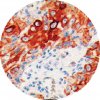
Fixed-embedded human lung cancer
Cytokeratin 14
Clone: D19-N
Cat#: DB 099
CK14 is a member of the type I keratin family of intermediate filament proteins, it has been reported to be expressed in neoplasms of squamous cell origin.
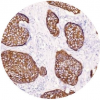
Fixed-embedded human squamous cell carcinoma
Cytokeratin 16
Clone: R20-S
Cat#: DB 100
CK16 is a type I cytokeratin. It is paired with CK6 in a number of epithelial tissues, including nail bed, oesophagus, tongue, and hair follicles. Mutations in the gene encoding this protein are associated with genetic skin disorders.
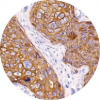
Fixed-embedded human skin squamous cell carcinoma
Cytokeratin 17
Clone: V21-R
Cat#: DB 101
In normal tissues, CKl7 is expressed by basal cells of complex epithelia, e.g. basal cells of pseudo-stratified epithelium in the trachea, larynx, bronchi, myoepithelial cells in salivary glands and sweat glands. In neoplastic tissue, CKl7 is expressed by squamous cell carcinomas of the lung, cervix and oral cavity.
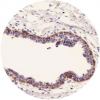
Fixed-embedded human breast
Cytokeratin 18
Clone: R20-H
Cat#: DB 102
CK18 is a 45 kD a protein, belongs to the family of acidic type A and exists along with CK8 in most simple ductal and glandular epithelia. This antibody does not react with squamous epithelium . It reacts with benign and malignant epithelial lesions, the major ity of adenocarcinoma s, and basal cell carcinomas.
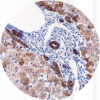
Fixed-embedded human liver
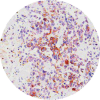
Fixed-embedded human lung adenocarcinoma
Cytokeratin 19
Clone: E16-L
Cat#: DB 103
The smallest human cytokeratin filament protein (40 kD) has been identified as CK19 and has been reported to be expressed in a large number of epithelial cell types, including many ductal and glandular epithelia.
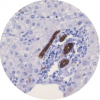
Fixed-embedded human liver
Cytokeratin 20
Clone: E19-I
Cat#: DB 119
CK20 has been demonstrated to be almost entirely confined to the gastro intestinal epithelium, urothelium and Merkel cells of the skin.
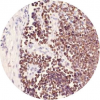
Fixed-embedded human Merkel cells carcinoma
Cytokeratin 5
Clone: XM26
Cat#: 10083
CK5 is an intermediate filament protein. Basal cells of epidermis express acidic CK14 and basic CK5. CK5 is a 58 kDa protein, which is closely related to CK6. XM26 can be useful in distinction of mesotheliomas from adenocarcinomas.
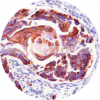
Fixed-embedded human lung squamous carcinoma
Cytokeratin 7
Clone: R17-S
Cat#: DB 051
CK7 has been reported in adenocarcinomas of the lung, breast, endometrium, ovary, thyroid as well as in carcinomas of the bladder and chromophobe renal cell carcinoma. CK7 and CK20 expression have been reported to show characteristic patterns on metastatic lung and adenocarcinomas.
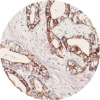
Fixed-embedded human pancreas adenocarcinoma
Cytokeratin 8
Clone: R15-K
Cat#: DB 098
CK8, also known as tissue polypeptide antigen (TPA), is one of the first cytokeratins expressed in the embryo and persists in adult tissues. It is a major components of all simple epithelia but not of stratified squamous epithelia.
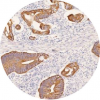
Fixed-embedded human colon adenocarcinoma

